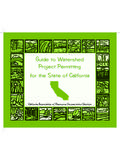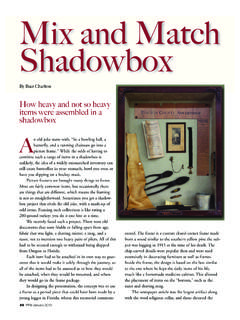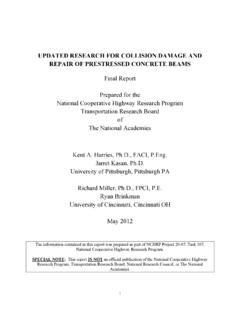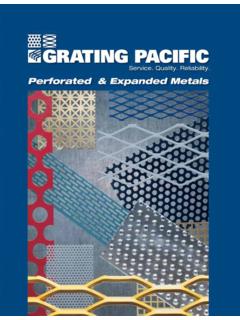Transcription of The Oregon Project
1 The Oregon Project For Visually Impaired & Blind Preschool Children Skills inventory Cognitive Birth - 1 Year alerts to daily tactual/visual/auditory/movement stimulation bats at toys suspended above crib in order to see or hear something interesting touches new objects inquisitively plays with own hands or feet anticipates some familiar daily events based on sensory cues combines three or more behaviors when exploring a toy ( , shakes, mouths, pats). indicates desire to continue a familiar activity shared with adult by movement and/or vocalization puts down one object deliberately to reach for another plays with toys by taking advantage of the best characteristics of each: rolls ball, shakes bell, crumples paper removes object from container by reaching inside moves (scoots or crawls) to obtain object when given a visual or auditory clue puts one object into another (discovers the concept of containers).
2 1- 2 Years puts many objects into a container before removing any opens container with lid to find sound-maker (ticking clock, music box). touches 1-3 body parts on request ( , nose, mouth, tummy). shows anticipation of events when verbal cue is provided (hears let s go outside and goes to coat closet). shows preference in choice of toys shows curiosity about a new toy demonstrates concept of up/down by moving self or object ( put the spoon down or hold your hand up high ). gives or touches 5 specific objects on request explores cabinets and drawers in own home selects, from group of 3, object identical to given object (eg., shoes, spoons, cups). 2 -3 Years demonstrates simple problem-solving (eg., uses tool to obtain object which is out of reach). demonstrates the use of familiar objects on request (hairbrush, crayon). matches big/little objects (identical in every other way).
3 Finds/touches big/little objects on request matches shapes (circle, square, triangle). The Oregon Project for Blind and Visually Impaired Preschoolers - Skills inventory Cognitive (cont'd). understands and gives just one . finds object when function is described ( show me the one you brush your teeth with ). demonstrates the concept of two touches smaller body parts (fingers, thumb, toes) on request touches body part when function is described ( show me what you hear with ). tells age verbally, or holds up fingers names 2-3 familiar musical toys and instruments by their sound names one color when asked (names, not recognizes or matches). sorts 3 kinds of dissimilar objects sorts similar objects by size, shape, or color 3 - 4 Years names 10 body parts turns to face an object/person on request touches top, bottom, front, back, and sides of an object on request identifies common environmental features indoors/outdoors (chairs, stairs, door, window, sidewalk, lawn).
4 Names object not present when function is described matches sound containers (beans, rice, marbles). names objects as same/different tells which objects go together (shoes/socks, spoon/plate). touches 3 named shapes on request (circle, square, triangle). names shapes arranges 3 items horizontally in order by size tells if object is heavy or light tells if object is long or short matches 1:1 (1 plate, 1 napkin, 1 child, 1 cookie). tells how many objects in a set (1-3) after counting matches simple sequence or pattern of 5 blocks, beads or pegs 4 - 5 Years tells own age comprehends concepts of today, last night, yesterday, tomorrow when discussed with adult identifies weather as rainy, sunny, snowy, warm, cold tells whether sound is loud/soft, high/low, long/short touches own complex body parts on request (wrist, shoulder, ankle, waist).
5 Moves body planes in relation to flat surface ( put your back against the wall ). touches and names left/right on own body places objects over/above, under/below, upon/inside, through, and away from other objects on request sorts similar household objects (silverware, clothing). Cognitive (cont'd). arranges objects into at least 3 groups (things to eat, wear, or play with). identifies picture/object which does not belong in group identifies objects as long/short, hard/soft, rough/smooth places 5 objects in horizontal arrangement by size rote counts to 10. counts objects from 1-10. gives no objects when asked for zero touches first, middle, last items in a row finds matching symbol (printed/raised outline) of geometric shapes tells whether 2 symbols are the same or different recognizes own name in print or braille puts 5 objects in pattern from memory (using alternating colors or shapes).
6 5 - 6 Years states full name, address, and phone number states full name of at least one parent states month and date of own birthday names 10 colors ( tell me all the colors you know ) item does not require vision identifies penny, nickel, dime names days of the week in order answers which is longer, a minute or an hour? A day or a week? places objects across from, next to, beside, behind, in front of, to the side, left and right of self on request places objects across from, next to, beside, behind, in front of, to the side, left and right of other objects facing in the same direction of self arranges 4-5 objects in sequence by length, width, or height identifies half and whole objects creates sets of objects of up to 5. names numerals 1 to 10 when presented matches numerals with same quantity of objects, 1 to 10. names ordinal position of objects (first, second, third).
7 Names numerals 11 to 20 when presented write numerals (print or braille) 1 to 20 in proper sequence rote counts to 100. identifies sets containing more/less using real objects, adds and subtracts combinations up to 3. states letters of the alphabet in order finds symbol that is different in a line of like symbols reads own first and last name identifies letters of the alphabet when presented (upper case, lower case, upper/lower mixed). reads 5-10 simple words Cognitive (cont'd). names object beginning with given consonant sound gives consonant sound of selected letters copies upper and lower case letters from flashcards (print or braille). copies two short words writes letters from dictation (upper and lower case). Language Birth - 1 Year has separate cry for different discomforts (hungry, wet, or tired). responds pleasurably to sound of human voice coos and gurgles repeats own sound imitates a familiar babbling sound repeats same syllable 2-3 times (ma ma ma).
8 Responds to simple phrases with specific non-verbal response ( want a drink? and child turns head away; let s go for a ride:, child gets excited). combines two different syllables in vocal play (da-dee, or ma-mee). vocalizes to gain attention imitates vocal intonation patterns of others uses single word appropriately (hot or cookie). vocalizes 5 or more syllables in response to speech of another person follows simple verbal direction accompanied by gestures or physical cue ( give me your hands ). 1 - 2 Years says 5 different words combines use of words and gestures to make wants known uses one-word sentences as requests ( drink or water ). asks for more in 3 appropriate situations follows 3 different one-step directions given without gestures names familiar objects, people, pets, when asked asks for common food items by name (milk, cookie, cracker).
9 Asks questions using a rising intonation at end of word or phrase answers yes or no when asked a question names parts of own face: ear, nose, mouth, eye, cheek 2 - 3 Years repeats a series of two digits or words in same order uses word for bathroom need names 2-3 animals, 2-3 items of clothing follows directions involving personal pronouns ( give it to her ). combines two words to express request ( drink water ). tells own current activity ( eat cookie , go potty ). combines two words to express possession ( daddy car ). gives more than one object when asked using plural form (blocks). names 10 objects or places (kitchen, sink, porch). articulates words beginning with the following consonants; p, b, m, h, w, n responds to two-part simple request ( pick up your blocks and put them in the toy box ). responds to questions using ing verb form (running).
10 Language (cont'd). uses regular plural forms (book/books). asks questions beginning with what , where , or when . controls voice volume (whispers or uses loud voice). speaks in three-word sentences uses I , me , mine , rather than own name articulates words beginning with these consonants: k, g, t, d responds to who questions uses is in statements ( this is a ball ). uses possessive forms of nouns (daddy s). occasionally uses articles the and a . 3 - 4 Years uses relative pronouns: that, this, these, those uses some adverbs (fast, now, too). uses open or closed as descriptors ( the door is closed ). uses some irregular past tense forms consistently (did, went, was). uses is at the beginning of questions appropriately repeats simple rhymes, songs, and fingerplays with words and actions tells first and last name when requested uses personal pronouns: he, she, it, they, you repeats a series of 3 digits or words in same order uses 3 descriptive words appropriately when presented with objects (sticky, bumpy).





